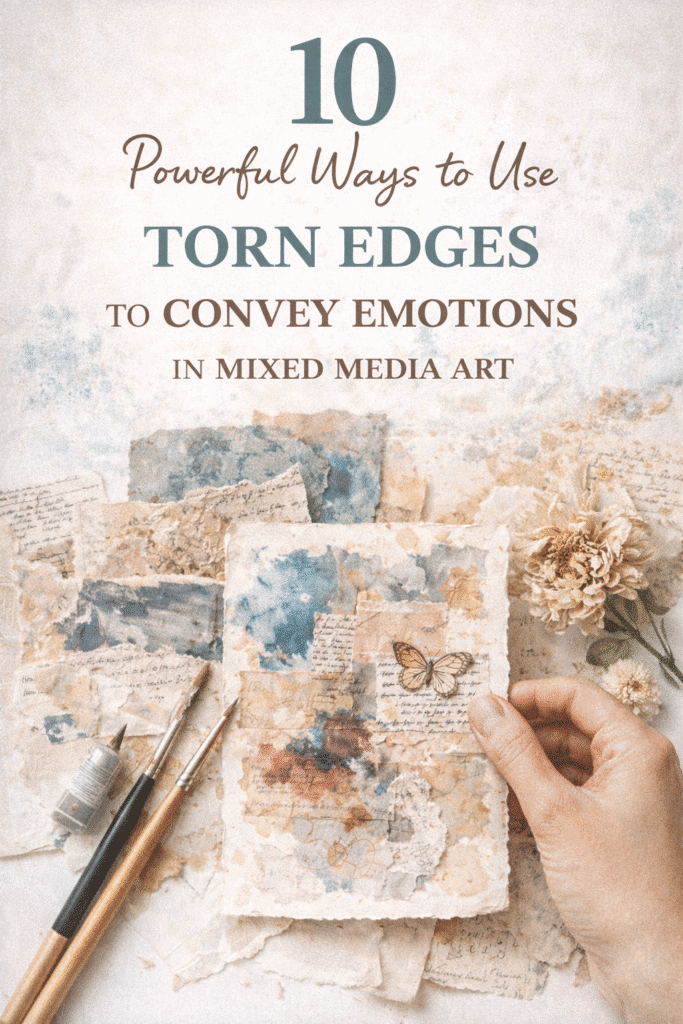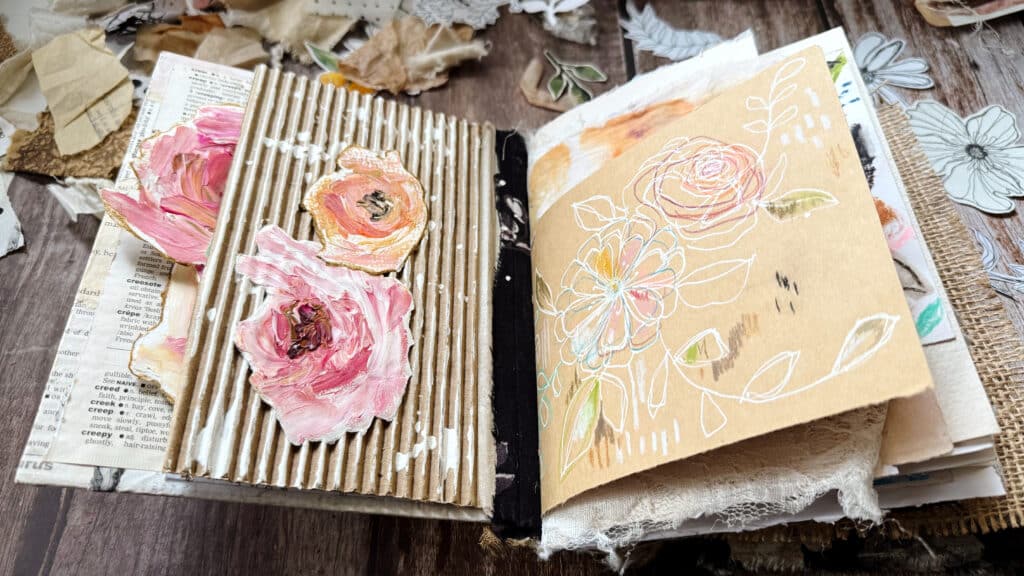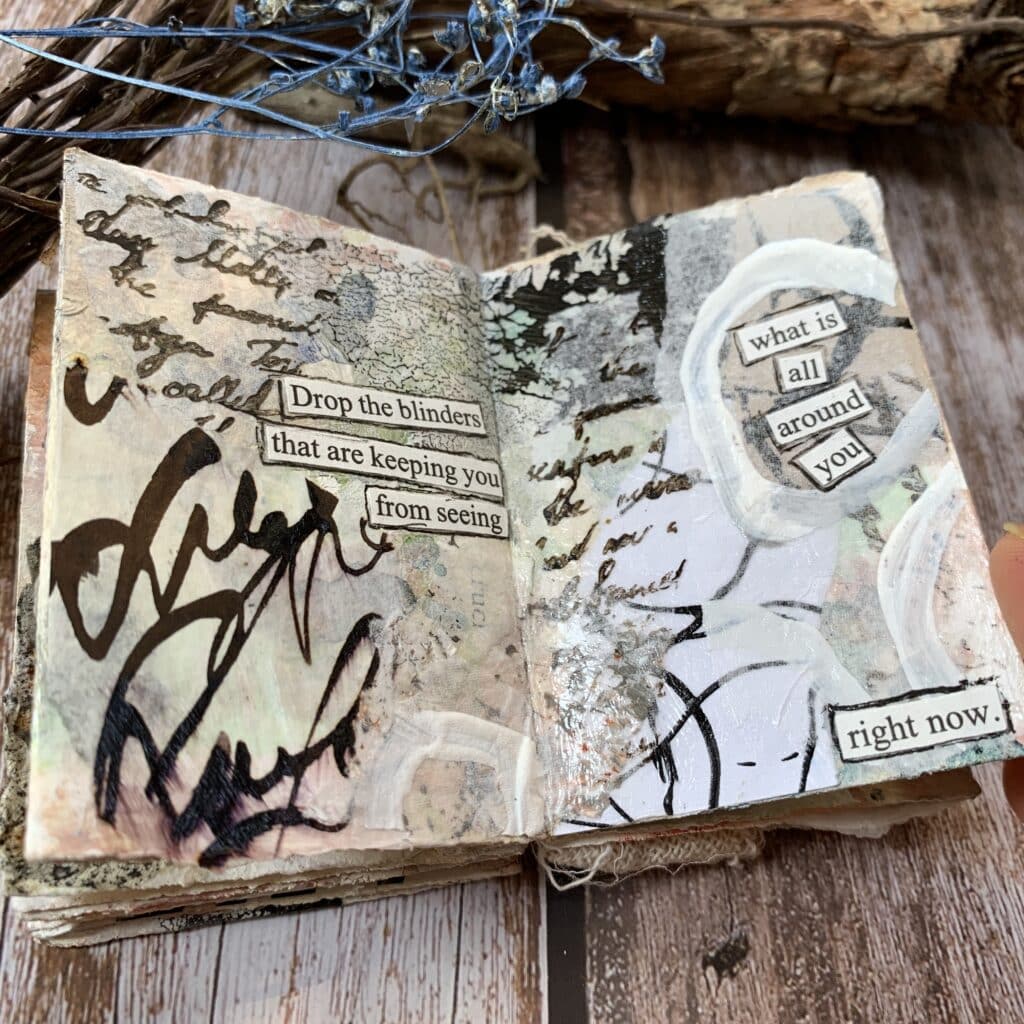Torn edges in mixed-media art can be a powerful way to convey emotions and add depth to your compositions.
In this article, we’ll dive into the fascinating world of torn edges and frays in mixed media art. We’ll explore what these elements represent and how you can use them to convey a wide range of emotions in your artwork.
By the end, you’ll have a treasure trove of techniques and ideas to enrich your creative expression. Ready to get started? Let’s go!
Symbolism of Torn Edges and Frays
Torn edges and frays are more than just accidental occurrences in mixed media art. They hold a powerful symbolism that can transform the meaning of your work. But what exactly do they represent? Torn edges often symbolize disruption, change, and emotional intensity. They invite viewers to see beyond the polished surface and into the raw, unfiltered core of the piece.
1. Embracing Imperfection
Torn edges symbolize the beauty of imperfection. In a world obsessed with perfection, these raw, uneven lines remind us that flaws can be beautiful and meaningful. They invite viewers to appreciate the art in its most authentic form, embracing the imperfections that make it unique. By incorporating torn edges, you celebrate the uniqueness of every piece, acknowledging that beauty often lies in the unexpected and the imperfect.
2. Capturing Raw Emotions
When you tear paper or fabric, it often feels like a release of pent-up emotions. This act of destruction can mirror intense feelings such as anger, frustration, or even heartbreak. The jagged edges left behind capture these raw emotions, making them tangible and visible to the viewer. This technique allows you to channel your feelings directly into your art, creating a visceral connection with your audience. Consider using torn edges to represent moments of emotional exposure, authenticity, or the beauty found in imperfections.
3. The Passage of Time
Frayed edges evoke a sense of nostalgia and history. They suggest that the material has been through a journey, weathered by time and experiences. This can add a layer of depth to your art, hinting at stories untold and memories long past. Using frayed edges can convey a sense of wear and tear, imbuing your piece with a narrative that speaks of endurance and the passage of time. Use torn edges to symbolize fragmented experiences, memories, or emotions. Arrange these torn pieces thoughtfully to tell a visual story.
4. Vulnerability and Fragility
There’s a certain vulnerability in frayed edges. They appear delicate and fragile, almost as if they could unravel at any moment. This can evoke feelings of tenderness and sensitivity, making your art more relatable and emotionally charged. By incorporating these delicate details, you can highlight the fragile nature of the human experience and the beauty found in vulnerability.
5. Process and Evidence
Evidence of Creation: Leaving an elemental torn edge as evidence of your artistic process adds authenticity. It shows that your work is not just a finished product but a journey.
Emotional Layers: As you layer torn pieces, consider the emotions associated with each layer. The act of tearing and arranging becomes a metaphor for emotional layering.
6. Texture and Sensory Experience
Tactile Sensations: Torn edges invite touch. Viewers can feel the roughness, the irregularity, and the history embedded in those edges. Texture engages our senses and enhances emotional impact.
Depth and Complexity: Layer torn pieces over one another. The overlapping edges create depth, mirroring the complexity of human emotions.
7. Color and Mood
Color Choice: The color of torn edges matters. Dark, moody colors may evoke sadness or introspection, while vibrant colors can express joy or passion.
Contrast: Experiment with contrasting torn edges—pair warm and cool tones, or light and dark shades. The juxtaposition intensifies emotional resonance.
How to Use Torn Edges to Convey Emotions in Mixed Media Art
1. Choosing the Right Materials
Different materials will tear and fray in unique ways, so choosing the right one is crucial. Paper, fabric, and even metal can be used to create different effects. Experiment with various materials to see how each one responds to tearing and fraying. For example, tissue paper tears easily and creates soft, wispy edges, while cardstock might give you more pronounced, jagged tears.
2. Paper Techniques
For paper, consider using your hands to tear it rather than scissors. This creates a more organic, natural look. You can also experiment with wetting the edges before tearing for a softer, feathered effect. Additionally, consider using different paper types like handmade paper, which adds texture and interest, or recycled paper, which can add a unique backstory to your piece.
3. Using Different Types of Paper
Try using different types of paper, such as tissue paper, handmade paper, or even newspaper. Each type will give you a different texture and look when torn, adding variety to your art. Handmade paper can provide a rich, tactile quality, while newspaper can introduce text and imagery that contribute to your narrative.
4. Fabric Techniques
When it comes to fabric, cutting small notches and then tearing along the grain will give you clean, straight frays. For a more distressed look, use sandpaper or a wire brush to rough up the edges. Each fabric type reacts differently—denim tears with a rugged edge, silk creates soft, elegant frays, and burlap offers a rustic, earthy texture.
5. Incorporating Different Fabrics
Mix and match fabrics like denim, silk, or burlap. Each fabric will fray differently, offering a range of textures and emotions. Denim, for example, can convey strength and resilience, while silk might evoke luxury and delicacy. Combining these materials in a single piece can create a rich tapestry of emotions and visual interest.
Layering for Depth
- Building Up Layers
Layering torn and frayed pieces can create a rich, textured surface that draws the viewer in. Play with different colors, patterns, and materials to build layers that convey the complexity of your emotions. Start with a base layer and gradually add torn pieces on top. This creates a sense of depth and dimension, making your art more dynamic and engaging.
- Mixing Media
Combine torn paper with paint, ink, or charcoal for a mixed media masterpiece. The contrast between the smooth, controlled strokes and the rough, torn edges adds visual interest and emotional depth. For example, pairing bold, jagged tears with soft watercolor washes can create a striking juxtaposition that highlights the emotional tension in your piece.
Conveying Specific Emotions with Torn Edges
1. Anger and Frustration
Want to express anger or frustration? Use bold, jagged tears and dark, intense colors. The sharp edges and harsh lines will mirror the intensity of these emotions. Consider incorporating harsh strokes of black ink or deep reds to amplify the sense of raw, uncontrolled emotion.
2. Sadness and Melancholy
For sadness or melancholy, opt for softer, more delicate frays. Light, muted colors and gentle, feathered edges can evoke a sense of sorrow and longing. Think of using pale blues and grays, perhaps with washes of watercolor that mimic the softness of tears or a cloudy sky.
3. Joy and Happiness
Even positive emotions can be expressed with torn edges. Use bright, vibrant colors and playful, irregular tears to convey joy and happiness. The spontaneity of the torn edges will reflect the carefree nature of these emotions. Bright yellows, oranges, and greens, paired with energetic, irregular tears, can convey a sense of exuberance and joy.
4. Calm and Serenity
For a sense of calm and serenity, choose soft, flowing tears and pastel colors. The smooth, gentle edges will evoke a feeling of peace and tranquility. Soft blues, greens, and lavenders, combined with flowing, gentle tears, can create a soothing, serene effect.
Incorporating Torn Edges into Your Art Practice
1. Finding Inspiration
Sometimes, the hardest part is knowing where to start. Here are some tips for finding inspiration to incorporate torn edges into your mixed media art.
2. Nature and the Environment
Look to nature for inspiration. The jagged edges of mountains, the frayed leaves of plants, and the weathered bark of trees can all inspire your torn edge techniques. Nature is full of textures and imperfections that can be mimicked in your art.
3. Personal Experiences
Draw from your own experiences and emotions. Think about times when you felt intense emotions and how you can translate those feelings into your art using torn edges. Personal experiences can provide a rich source of inspiration, making your art more authentic and relatable.
4. Other Artists
Study the work of other artists who use torn edges in their mixed media art. See how they incorporate this technique and what emotions they convey, then adapt their methods to fit your own style. Learning from others can spark new ideas and approaches in your own work.
Experimentation and Play
1. Letting Go of Perfection
One of the most important things to remember when working with torn edges is to let go of perfection. Embrace the unexpected and allow the process to unfold naturally. This mindset will free you to explore new possibilities and discover unique ways to express your emotions.
2. Trying New Techniques
Don’t be afraid to try new techniques and materials. The more you experiment, the more you’ll discover what works best for you and how you can use torn edges to convey your emotions. Experimentation is key to finding your unique voice and style.
3. Keeping a Sketchbook
Keep a sketchbook dedicated to experimenting with torn edges. This can be a place where you try out new ideas, make mistakes, and refine your techniques without the pressure of creating a finished piece. A sketchbook allows you to explore freely and document your creative journey.
Conclusion
Torn edges and frays in mixed media art are powerful tools for conveying a wide range of emotions. Whether you’re expressing anger, sadness, joy, or serenity, these techniques can add depth and complexity to your artwork. So, grab some paper, fabric, and whatever else inspires you, and start tearing and fraying to your heart’s content. You’ll be amazed at the emotional impact these simple techniques can have on your art.
What emotions do you want to explore in your mixed media art? How will you use torn edges to convey them? Share your thoughts and experiences in the comments below!
FAQs
Can I use torn edges in digital art?
Yes, you can! There are various digital tools and brushes that mimic the look of torn edges. Experiment with these to achieve a similar effect in your digital artwork.
What types of paper work best for tearing?
Handmade paper, tissue paper, and newspaper are great for tearing. Each type will give you a different texture and look, so try out a few to see what you like best.
How do I prevent fabric from fraying too much?
To control fraying, you can use fabric glue or fray check on the edges. This will help keep the frays in check while still giving you that raw, distressed look.
Can I use torn edges in other forms of art besides mixed media?
Absolutely! Torn edges can be used in collage, scrapbooking, and even sculpture. The possibilities are endless, so don’t be afraid to get creative.
What’s the best way to layer torn pieces?
Start with a base layer and gradually add torn pieces on top. Play with different colors, textures, and materials to create a rich, layered effect.






